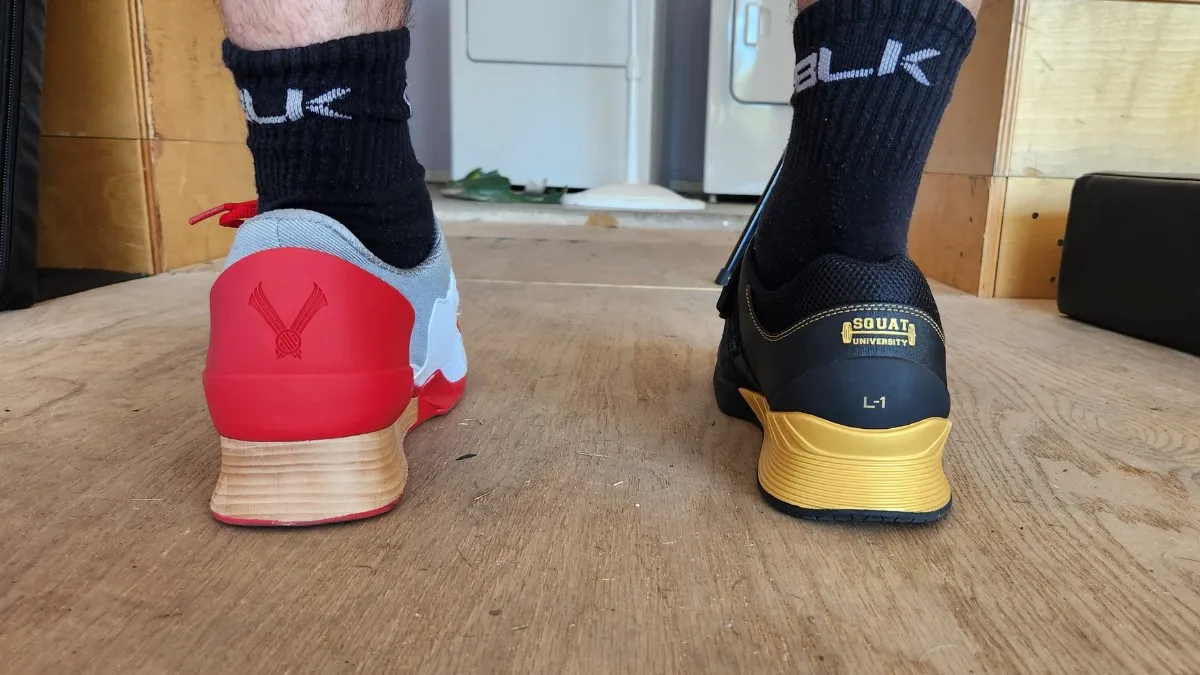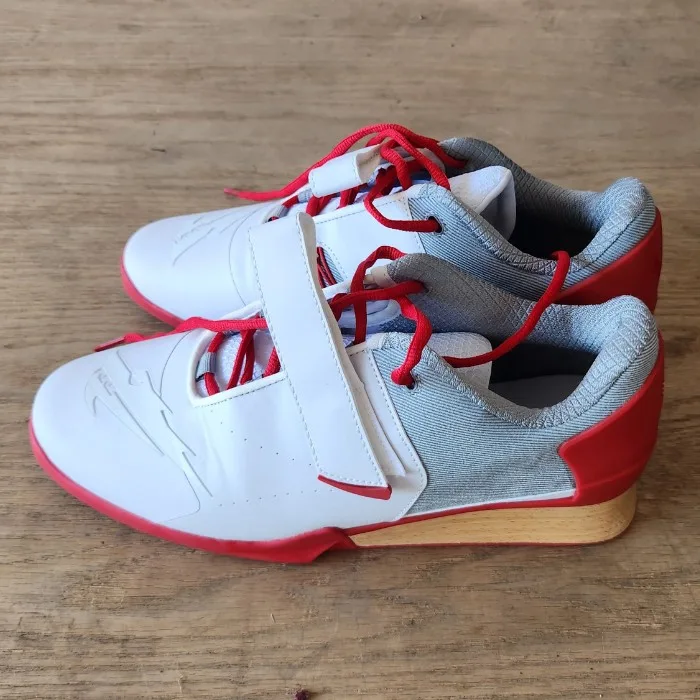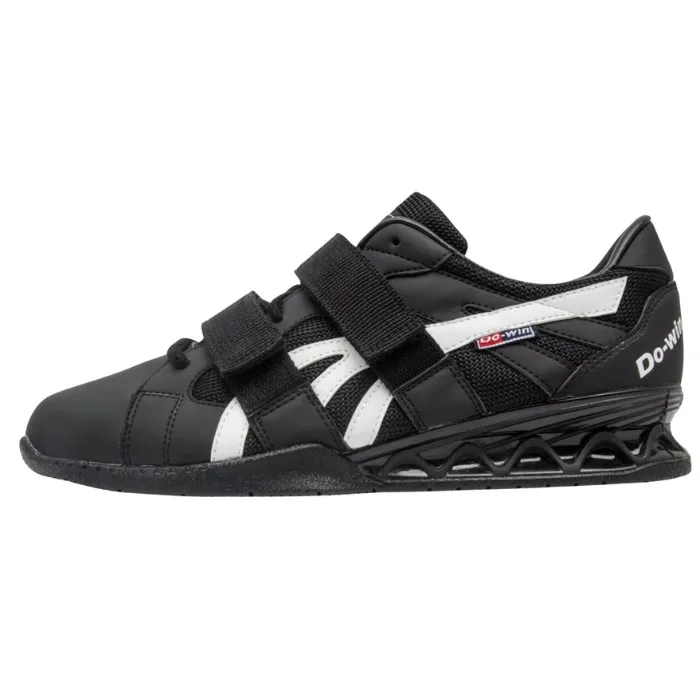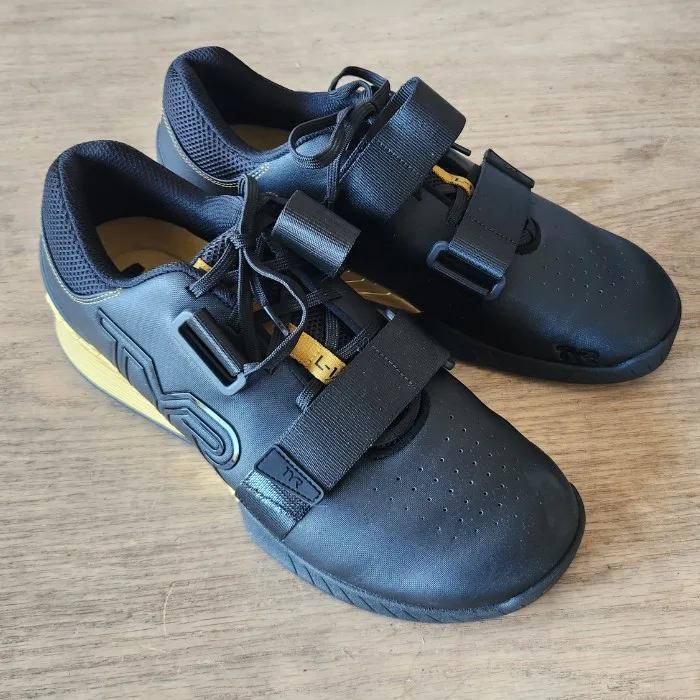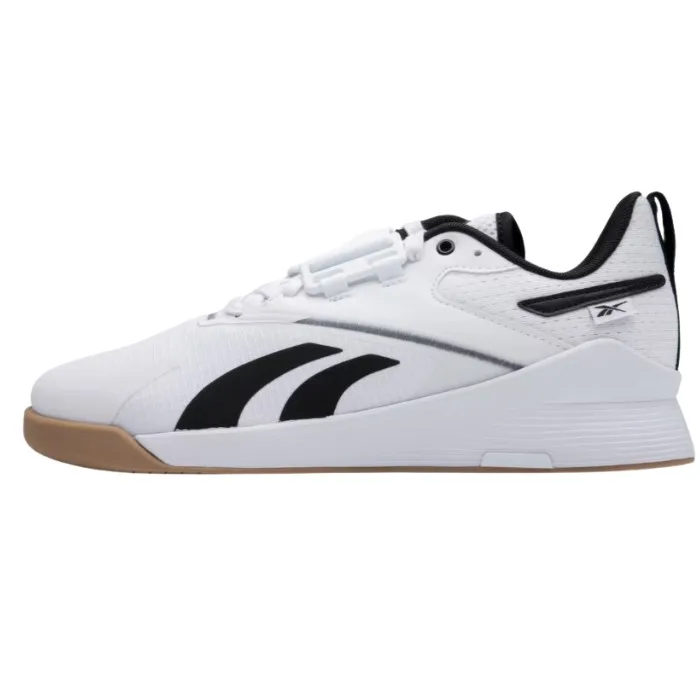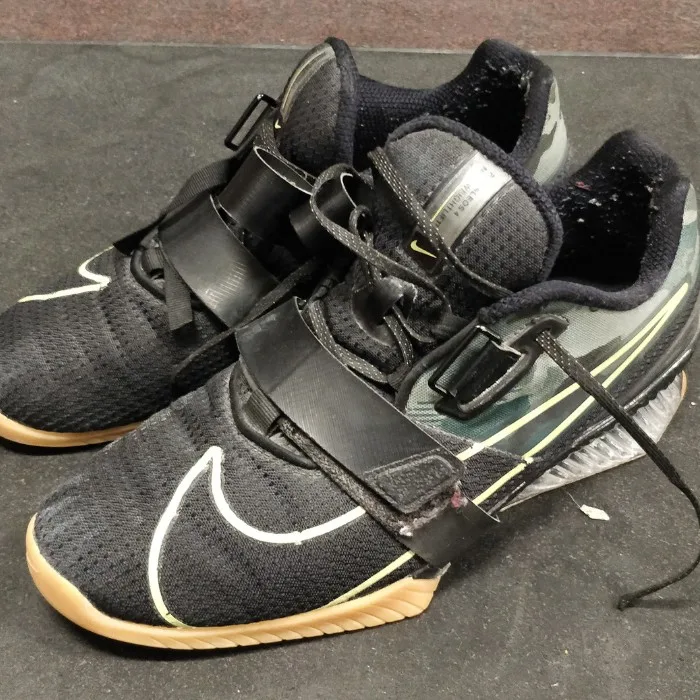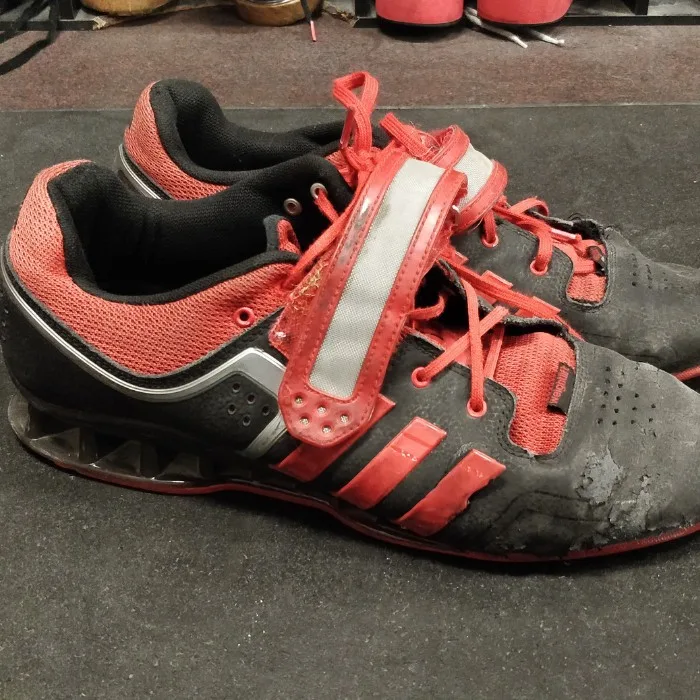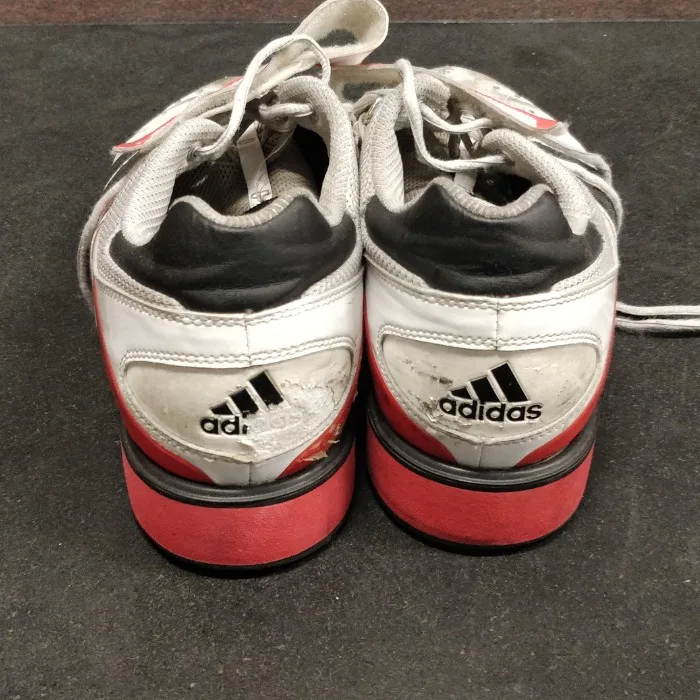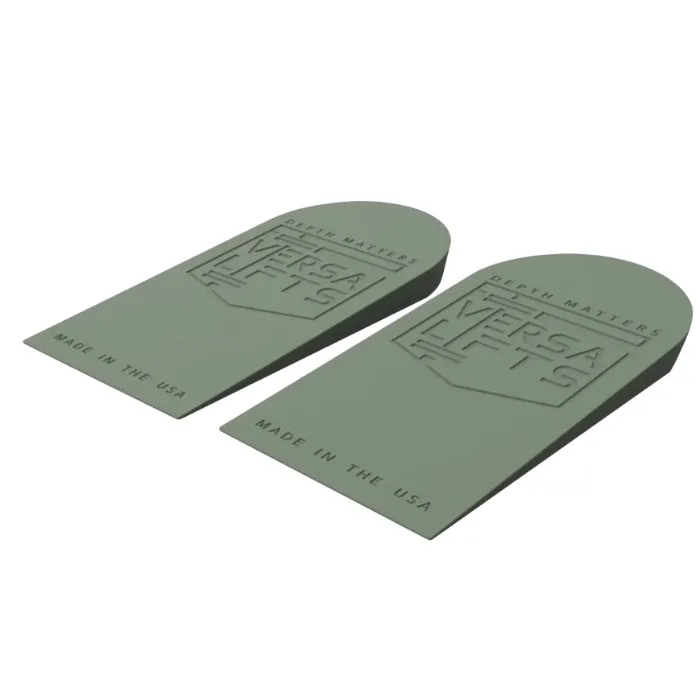Do you need weightlifting shoes? Not necessarily.
But if you are serious about hitting new PRs or competing in Olympic Weightlifting, you need Weightlifting shoes.
I’ve been a National level competitive Weightlifter, and my wife is an International medalist, having competed in Olympic Weightlifting at the elite level for 20 years.
Safe to say, we’ve tried almost every shoe imaginable. Here are our top picks.
- Best Weightlifting Shoes: Velaasa Strake
- Best Budget Weightlifting Shoes: Do-Win Weightlifting Shoes
- Best Weightlifting Shoes For Women: Velaasa Strake
- Best Weightlifting Shoes For Wide Feet: TYR L-1 Lifters
- Best Weightlifting Shoes For Beginners: Reebok Lifter PR III
- Best Weightlifting Shoes For Flat Feet: Nike Romaleo 4
- Best Weightlifting Shoes For Narrow Feet: Adidas Adipower 3
- Best Weightlifting Shoes For Squats: Adidas Powerlift 5
- Best Weightlifting Shoes For CrossFit: Inov-8 F-Lite 235 V3
- Best Weightlifting Shoes For Poor Ankle Mobility: Versalifts
- Best Weightlifting Shoes On Amazon: Inov-8 Mens Fastlift 360
|
4.5
|
3.8
|
3.9
|
|
$249.99
|
$105
|
$199.99
|
|
Heel Construction:
Wood
|
Heel Construction:
TPU
|
Heel Construction:
TPU
|
|
Heel Height:
0.86" (22mm)
|
Heel Height:
0.75" (19mm)
|
Heel Height:
0.82" (21mm)
|
Best Weightlifting Shoes
Velaasa Strake
- A classic wooden heel that provides an unbeatable feel.
- A taller 0.86″ heel is perfect for people with less mobility.
- Tight-fitting and comfortable.
- High-quality materials and exceptional durability.
- The fit may be too snug for wider feet.
This is my absolute favorite weightlifting shoe.
With its exceptional quality and iconic wooden heel, they outperform all other top brands and models. Wooden heels are difficult to find in modern weightlifting, as many manufacturers prefer high-density plastic.
While plastic heels are more durable, the classic wooden heel will never go out of style. Furthermore, wood has been demonstrated to absorb some of the energy and shock from weightlifting, making it a little gentler on the joints.
Wood gives a much greater platform feel than synthetics, and the “crack” of wood on wood is unparalleled.
I don’t even need to use the foot straps because they fit my feet snugly and comfortably. I feel stable with these shoes, and I’ve carried 200 kg on my shoulders while wearing them, so you know they’re tough.
The soles are made of a thin rubber layer with a diamond-carved design to prevent slipping on the platform.
They have a slightly greater heel height than typical weightlifting shoes, measuring 0.86″ to assist in getting into the bottom position.
Depending on how tight you want your shoes, go up a half to a full size. I generally wear a size 10, and the 10.5 Velaasa Strake fits me nicely.
I have wide feet and cannot fit into Adidas Adipowers, so I usually wear my trusty Nike Romaleo 2s. However, the Velaasa Strakes fit great, so they are still a choice even if you have bigger feet.
Best Budget Weightlifting Shoes
Do-Win Weightlifting Shoes
- A budget weightlifting shoe that is actually worth it.
- The dual strap system provides a more secure fit.
- They have a wider toe box, allowing for a good toe splay.
- Only one colorway.
- Not on par quality-wise with the more premium options.
Do-Win is one of the oldest weightlifting shoe companies, and its designs have developed over time. Old Do-Wins had wooden heels, but their newer, less expensive version has a TPU plastic heel like Nike and Adidas.
These Olympic weightlifting shoes have a standard 0.75″ heel and offer proper heel elevation. The exterior layer is made of synthetic leather and nylon mesh, which stretches over your foot.
The Do-Wins have two-foot straps and a large toe box for a more secure fit. These fit similarly to the Nike Romaleo 2s and Tyr L-1, which are both excellent for wide feet.
You have only one design option: black. When purchasing them, be sure to size up half a size. These are frequently available for less than $100 when on sale.
I usually recommend people buy more expensive shoes, but the Do-Wins on a sale are worth it.
Best Weightlifting Shoes For Women
Velaasa Strake
- A classic wooden heel that provides an unbeatable feel.
- A taller 0.86″ heel is perfect for people with less mobility.
- Tight-fitting and comfortable.
- High-quality materials and exceptional durability.
- The fit may be too snug for wider feet.
Why am I including the Velaasa Strake a second time, you might ask? Because I like them so much.
My wife has been a competitive weightlifter for 20 years and has tried almost every available weightlifting shoe worth trying, and the Velaasa Strake is her favorite.
Not to mention, the white version looks stunning. So I can easily recommend the Velasa Strake as the best Olympic weightlifting shoes for women who want the best possible option.
Best Weightlifting Shoes For Wide Feet
TYR L-1 Lifters
- The widest toe box available.
- Standard heel drop of 0.82".
- Flat and wide soles for great stability.
- Many color options.
- It may be too wide for some people, and the overall feel differs from other shoes.
TYR has established itself in the lifting industry with its ultra-wide L1 Lifters. I have never worn a shoe with such a large toe box, which makes it ideal for heavyweights with large feet.
I frequently have difficulty with tiny toe boxes, which is why I’ve always returned to my Romaleo 2s.
The TYR L-1 Lifters have the largest toe box of all the weightlifting shoes I’ve tried. This is great for people with extra-wide feet, as it allows for a full toe spread. The fit is comparable to barefoot shoes if you’ve worn some.
However, this could be a downside for some people, as the extra space inside can hinder those who want the best possible performance.
The heel is composed of TPU plastic, which is robust but less rigid than wood.
The 0.82″ heel allows for a smooth transition to the bottom position. Because the shoe is so wide, it incorporates two-foot straps for further security. It fits true to size, so choose your usual shoe size.
Best Weightlifting Shoes For Beginners
Reebok Lifter PR III
- An inexpensive but well-made model perfect for beginners.
- The softer and lower heel makes them more versatile.
- EVA heel absorbs more force than wood and TPU and can reduce your power output.
The Reebok Lifter PR 3 is one of the best weightlifting shoes a beginner can buy. When starting out, you want a shoe that will do the work without breaking the budget, and the Reebok Lifter PR III is perfect for the task.
They cost slightly more than $100 and have the most essential features of a weightlifting shoe.
These shoes have a slightly lower heel height (0.70″) than regular weightlifting shoes, yet this elevation is sufficient for easily hitting deep squats.
This model’s heel height is lower than Reebok’s previous one. They use an EVA foam heel, which is less dense than a TPU or wood heel and performs less effectively.
However, it is adequate for a beginning weightlifter.
The sole has a rubber outer layer for grip, and the one-foot strap allows for a better fit. They come in black or white and are a great place to start as your first weightlifting shoe.
Best Weightlifting Shoes For Flat Feet
Nike Romaleo 4
- Perhaps the most stable weightlifting shoes on the market.
- The TPU heel lacks the feel of wood, but it offers the best durability.
- A pair of Nike Romaleos will last you for a long time.
- Good arch support and medium wide toe boxes make them preferable for people with flat feet.
- One of the heavier shoes on the list.
- Lacks the feel of a wooden heel.
Nike has been making high-quality weightlifting shoes since the first Nike Romaleo debuted many years ago.
These are no exception, given their previous three models. If you’ve worn Romaleo models before, the Romaleo 4’s foot straps will feel different, with the second strap sitting slightly higher up the foot.
It’s an interesting change from the Romaleo 2, which I don’t believe was required, but it’s an improvement over the Romaleo 3s’ one-foot strap.
The shoe’s bottom is identical to the Romaleo 2 design but with more modern, “sharper” edges for a sleeker look. The increased stability can be felt because the shoe’s sole is slightly longer and wider in some locations than the shoe itself.
Sizing is accurate, and the shoes fit similarly to previous Romaleo models. However, they are slightly thinner in the toe box than the Romaleo 2, which was previously thought to be the best shoe for wide feet.
The Nike Romaleo 4 are among the best weightlifting shoes overall, but they are also a preferred choice for many people with flat feet. Having flat feet is not a single condition people have, and no single model will work for everyone.
However, flat feet generally need better arch support and a wider toe box to fully spread the toes, and the Nike Romlao provides both.
Best Weightlifting Shoes For Narrow Feet
Adidas Adipower 3
- The dense midsole and heel offer exceptional stability and traction.
- Ripstop upper is durable and breathable.
- 0.86" heel is perfect for serious Olympic-style weightlifters.
- If you have narrow feet and want a snug fit, no shoe will fit you better than this.
- Notoriously narrow toe box.
The Adidas Adipower III is a premium weightlifting shoe. These performance shoes include a 0.86″ heel height, a high-density TPU midsole, lateral support, and a rubber outsole for traction.
The ripstop upper is durable yet super breathable, and the interior reinforcement of the forefoot is designed for lateral support in every step. These are top-of-the-class Olympic weightlifting shoes.
However, Adidas Adipowers are notoriously narrow. Consider how they compare to the Velaasa Strake, a mid-width shoe. A quick glance at the toe box shape of the Adipowers is enough to understand how narrow they are.
My feet are large, and I can never fit into Aidipowers. Therefore, keep this aspect in mind if your feet are not narrow. But for lifters with narrow feet, it’s hard to find a better model than the Adipower 3.
Best Weightlifting Shoes For Squats
Adidas Powerlift 5
- A great value Adidas shoe with a guaranteed solid build quality.
- If you are not into Olympic weightlifting but want a solid squat shoe, this is a great value option.
- Not as narrow as the Adipower.
- EVA foam is not as reliable or as solid as TPU and wood.
The Adidas Powerlift 5 are budget and beginner-friendly weightlifting shoes. As the name suggests, they are geared more toward powerlifters than Olympic-style lifters, and the materials, construction, and heel height reflect that.
The 0.6″ EVA heel translates well into all kinds of different exercises in the gym. However, because EVA is softer and compresses more than TPU and wood, despite the name, high-level powerlifters will not like the shoe.
But as an affordable, low-maintenance offering with the Adidas brand on it, the Powerlift 5 can be a great budget-friendly option for recreational athletes and budget-conscious competitors.
They are much cheaper than the Adipower and are not as narrow, meaning regular people can also fit their feet inside the Powerlift 5.
So, if you want the core characteristics of a squat shoe and don’t want to spend the cash for premium weightlifting shoes, the Powerlift is an excellent option.
Best Weightlifting Shoes For CrossFit
Inov-8 F-Lite 235 V3
- A lightweight and flexible shoe suitable for all modalities of CrossFit.
- Provides exception stability and protection for a barefoot shoe.
- Zero drop is great for deadlifts and for people with good mobility.
- Not a weightlifting shoe in the traditional sense and does not provide the elevated heel benefits of all other models.
There is no perfect shoe for CrossFit and weightlifting. CrossFit involves a lot of running, jumping, climbing, and other movements that require agility and flexibility, which is the opposite of what weightlifting shoes do.
Regular training shoes may be comfortable for running and jumping but are awful for heavy weightlifting because the soft cushioning absorbs the power instead of allowing you to generate it upwards.
In my opinion, the best option is to pick a zero-drop shoe that doesn’t compress. This way, you will be able to perform all activities without needing to change shoes.
The Inov-8 is an excellent choice designed precisely for this purpose. They have minimal cushioning and zero drop, meaning you won’t lose any power when doing power cleans.
At the same time, they are comfortable and designed as multipurpose shoes for all kinds of training.
The sticky rubber outsole provides a fantastic grip for climbing, while the TPU toe protector and a special laces system protect the feet when climbing rope. These features are found in very few barefoot shoes.
Best Weightlifting Shoes For Poor Ankle Mobility
Versalifts
- Add an extra half an inch to your current Weightlifting shoes removing ankle mobility restrictions.
- Can be added to any type of shoe.
- Not a substitute for dedicated Weightlifting shoes.
The Versalift heel inserts are a cheap and effective solution for ankle mobility. I would argue that improving ankle mobility through deliberate training is better, but Veraslifts are the second-best thing.
Instead of buying dedicated weightlifting shoes, you can insert these 1/2” in your normal trainers and get elevated heels. Consider it a substitute for the old trick of putting a weight plate under your heels when squatting.
The high-durometer polymer construction can withstand some heavy loads and may even improve the force loss from regular trainers’ soft heels.
If ankle mobility is your only issue and you want to make your favorite sneakers more “weightlifting” friendly, you can give Versalifts a try.
Best Weightlifting Shoes On Amazon
Inov-8 Mens Fastlift 360
- A lower heel than the rest of the shoes on the list, which is preferable by some people.
- A TPU heel on a shoe in the mid-price range.
- The lower heel may make it hard for less mobile lifters to hit depth.
These weightlifting shoes have two functions. They have a large structure and toe box, which is ideal for people with wide feet.
Their second distinctive characteristic is the 0.65″, lower than the standard but perfect for folks with compromised knees.
Lower heel height means less forward knee movement and may be harder for lifters with stiff ankles to hit depth.
The Inov-8 is considered more of an entry-level Weightlifting shoe, and the lower heel makes it more versatile than most other models.
They are also lighter than much of the competition. The flexible and lightweight upper is why the model was named the Fastlift 360.
How To Pick The Best Weightlifting Shoes
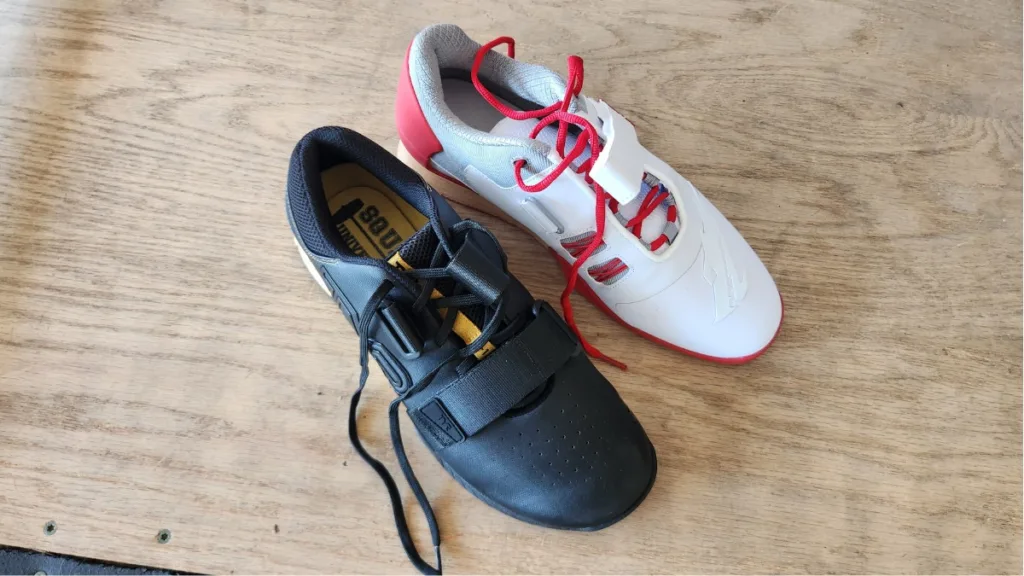
Picking the best weightlifting shoes involves a few factors, such as heel height, heel material, toe box width, and personal build and preferences.
Your choice should also bring the best value per dollar. Different sports use Weightlifting shoes, and specific body types require slightly different shoes.
This is why our list is so extensive, and every offer has a place.
An important note about the price is that while value for money is important, don’t be cheap when it comes to Weightlifting shoes.
There is a solid chance you will be using one pair (if it’s a high-quality one) for years. If you buy nice, you won’t have to buy twice and spend more money in the long run.
Heel Height
This is one of the most essential features to look for when buying a weightlifting shoe. Some people prefer higher heels, while others prefer lower heels. It usually comes down to personal preference or the contour of your body.
The standard heel size is 0.75″, and when in doubt, this is the default option. A lower heel height is a possibility if you have a history of knee problems or can sit in a perfect squat barefoot.
Many weightlifting shoes today have 0.86″ heels, which makes hitting the bottom positions on snatches and cleans easier. Higher heels are also better when you have poor ankle mobility (you can’t comfortably sit in a barefoot full squat).
Having been lifting in Velaasa Strakes, the 0.86″ heel feels great.
Heel Material
While not as important as heel height, the material of the heel can impact your decision. Wooden heels have a high durometer rating, so they won’t deform.
They also provide that classic, old-school feel with greater “feedback” from the platform.
TPU plastic is the other primary material used in most modern weightlifting shoes, and it lasts longer than wood.
It is lighter than wood or leather while providing superior stability and durability. However, it lacks the solidity, rigidity, and feel of wood.
Because it is less stiff, EVA foam is used in low-cost weightlifting shoes. EVA does not provide the same level of stability and force transfer. Instead, it absorbs shock and is more suited to CrossFit-style training.
A wood or TPU heel is essential for improving your weightlifting performance. EVA foam is an excellent option for a hybrid shoe or when you are on a tight budget.
Toe Box Width
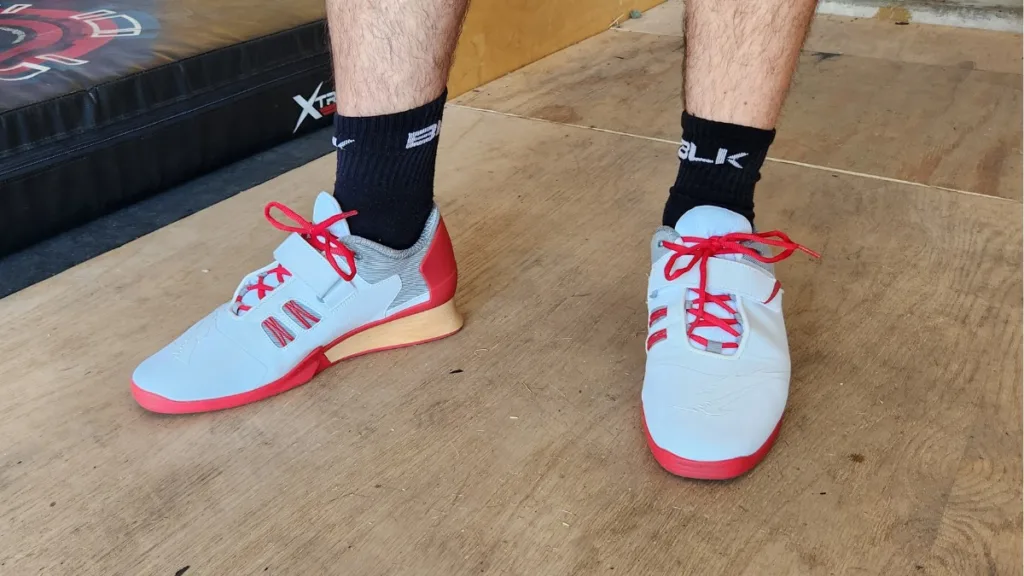
This is the second most crucial feature to look for in an Olympic weightlifting shoe. I, for example, have really wide feet and have trouble with narrow shoes in general.
Some shoes are simply not intended to fit larger feet. Adidas is infamous for ill-fitting broad feet. So, if you have wider feet, you may rule them out.
Nike is a much better brand for individuals with wide feet, although its most recent models are becoming narrower, and it is starting to lose its reputation.
A wider toe box allows you to spread your toes, which provides better stability. At the same time, the narrower box is intended to allow the transfer of more power.
Here is a quick breakdown of the relative toe box widths of the shoes on this list:
- Largest toe box widths: TYR, Reebok
- Moderate toe box widths: Velaasa, Nike, Do-win, Invo8
- Small toe box widths: Adidas
Shoe Material
We’ve covered the heel material, but the rest of the shoe materials are also important. The better the materials, the longer the shoes will last.
Genuine leather or high-quality synthetic alternatives are the best and strongest options. Mesh, knit, or similar materials provide more breathability but are easier to tear through.
Stitching and gluing quality are also important for durability. Higher-class shoes have reinforced and consistent stitching all around.
Price
I’ve included pricing as a factor while selecting Weightlifting shoes, not for financial reasons, but since the price usually signals the quality.
Expect to spend around $200 for high-quality weightlifting shoes. Weightlifting shoes in the mid-range go for around $100. Half the price may sound attractive, but I promise you’ll need to replace them sooner than you’d want.
Shoes with rubber soles and heels are the worst, and purchasing them for weightlifting is a waste of money.
Spending an extra $100 on your shoes can ensure they last for decades. Whether you’re a beginner or not, it’s worth the investment to have them for life.
Frequently Asked Weightlifting Shoe Questions
Summary
I love premium products that help me achieve my best, and in the case of weightlifting shoes, this is the Velaasa Strake. Their build, features, look, and wooden heel are unbeatable by any other model currently on the market.
But this doesn’t mean other models are not worth your cash and attention. For people with really wide feet, I can recommend the Tyr L-1, while budget-conscious lifters have a solid choice between the Reebok PR Lifter 2 and the Adidas Powerlift 5.
The Nike Romaleos and Adidas Adipower are premium options with a modern TPU heel and aesthetics, while the Inov-8 Bare is a minimalist shoe many CrossFitters may love.
- A classic wooden heel that provides an unbeatable feel.
- A taller 0.86″ heel is perfect for people with less mobility.
- Tight-fitting and comfortable.
- High-quality materials and exceptional durability.
- The fit may be too snug for wider feet.
